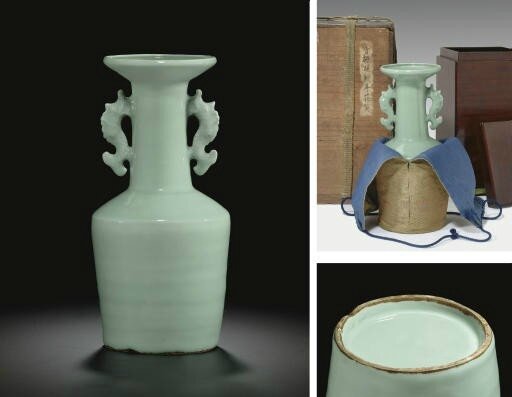A very rare Longquan celadon kinuta vase, Southern Song dynasty (1127-1279)
Lot 528. A very rare Longquan celadon kinuta vase, Southern Song dynasty (1127-1279); 11 ¼ in. (28.6 cm.) high. Estimate USD 10,000 - USD 15,000. Price realised USD 275,000. © Christie's Images Ltd 2018
vase is robustly potted with a mallet-shaped body with angular, sloping shoulders, rising to a tall neck flanked by a pair of handles in the form of dragon-headed fish, below the widely flared, dish-shaped mouth. The vase is covered overall with an even glaze of soft sea-green color, leaving the greyish foot ring unglazed, Japanese double wood box.
Provenance: Mayuyama, Tokyo
Literature: Christie's, The Classic Age of Chinese Ceramics: An Exhibition of Song Treasures from the Linyushanren Collection, Hong Kong, 2012, pp. 176-177, no. 75.
Rosemary Scott, ‘Chinese Classic Wares from a Japanese Collection: Song Ceramics from the Linyushanren Collection’, Arts of Asia, March-April 2014, pp. 97-108, fig. 20.
Exhibited: Christie's, The Classic Age of Chinese Ceramics: An Exhibition of Song Treasures from the Linyushanren Collection, Hong Kong, 22 to 27 November 2012; New York, 15 to 20 March 2013; London, 10 to 14 May 2013.
Note: The shape of the current censer originates from archaic bronze lian vessels from the Han dynasty (206 BC - AD 220). Ceramic vessels of this form are often molded with bow-strings around the body, such as the well-known Northern Song Ru censer in the Percival David Collection, illustrated in Sekai Toji Zenshu, vol. 12, Tokyo, 1977, p. 70, no. 62. An almost identical Longquan tripod censer, in the collection of the Hangzhou Archaeological Bureau, is illustrated by Zhu Boqian (ed.), Celadons from Longquan Kilns, Taipei, 1998, p. 149, no. 116. A small Longquan censer of similar form was discovered in 1991 in Suining, Sichuan province, amongst a cache of ceramics dating from the late Southern Song period, and is illustrated in Newly Discovered Southern Song Ceramics, A Thirteenth-Century “Time Capsule”, Tokyo, 1998, p. 32, no. 23.
Longquan vases with the type of handles seen on the current vessel are rare. The handles are in the shape of yulong (dragon-fish) with fish-like bodies and dragon-like heads. Dragon-fish are mentioned in Chinese literature as early as the Bronze Age, and appear in legends related in the Shanhaijing (Classic of Mountains and Seas). They were included in painted and incised decoration on ceramics of the Tang dynasty, from kilns such as Changsha and Yue, but do not seem to occur in three-dimensional ceramic form until the Song and Liao dynasties. By the Song dynasty, handles such as these depicted a carp in the process of turning into a dragon. This evokes a legend, which dates from at least as early as the Eastern Han dynasty (AD 8 - 220), that tells of the carp swimming up river to the Dragon Gate. If it is successful in leaping over the gate it turns into a dragon. This legend soon came to represent the success of the Chinese scholars, who studied hard to pass the civil service examinations, and if they achieved the highest grade would attain an official post.
As mentioned above, vases with dragon-fish handles are quite rare, and the current vase is even more rare for being unusually large, as well as having an unusually fine glaze. The majority of Longquan mallet vases are significantly smaller. A Longquan mallet vase with dragon-fish handles, excavated in 1983 from a Southern Song tomb in Songyangxian, which is only 16 cm. high, is illustrated by Zhu Boqian (ed.), Celadons from Longquan Kilns, Taipei, 1998, p. 149, no. 116; while the fine example from the Barlow Collection, now in the Victoria and Albert Museum, is only 16.8 cm. high, see Rose Kerr, Song Dynasty Ceramics, London, 2004, p. 94, no. 95. Further smaller vases of this type include two in the Carl Kempe Collection illustrated by Bo Gyllensvärd, Chinese Ceramics in the Carl Kempe Collection, Stockholm/Güteborg/Uppsala, 1962, p. 51, no. 98 (20 cm. high) and no. 99 (26 cm. high); a third vase in the Njoo Collection (also 26 cm. high) is illustrated in the exhibition catalogue Chinese Celadons and Other Related Wares in Southeast Asia, Singapore, 1979, pl. 73, left; and a fourth example (25.7 cm. high) was recovered from the wreck of a vessel which sank off the Sinan coast of Korea in about 1323 on its way to Japan, and is illustrated in Xin'an haidi wenwu (Cultural Relics from the Sinan Seabed), Seoul, 1977, no. 3.
Mallet vase with fish-shaped handles, porcelain with green glaze, Lonquan area, China, Southern Song dynasty, about 1250-1279. Height: 16.7 cm, Diameter: 7.3 cm. Given by Sir Alan Barlow, Bart.,GCB, KBE, and Lady Barlow, C.103-1967 © Victoria and Albert Museum, London 2017
There appear to be only two other published examples of a Longquan mallet-shaped vase with dragon-fish handles that comes close to the imposing size (28.6 cm.) of the current vessel: one is the vase in the Brodie Lodge Collection (28 cm. high) included in the Oriental Ceramic Society exhibition, The Arts of the Sung Dynasty, London, 1960, no. 173, pl. 64, right; the other is the Lord Matsudaira Fumai’s kinuta vase (28.8 cm. high) which was sold at Christie’s New York, 19 March 2008, lot 561.
Lord Matsudaira Fumai’s important Longquan celadon 'Kinuta' vase, Southern Song dynasty (1127–1279). Estimate USD 800,000 - USD 1,200,000. Price Realised USD 2,281,000 at Christies New York, 19th March 2008, lot 561. Photo Christie's Images Ltd 2008.
Cf. my post: An important Longquan celadon "Kinuta" vase, Southern Song Dynasty (1127-1279)
Christie's. The Classic Age of Chinese Ceramics - The Linyushanren Collection, Part III, 22 March 2018, New York

/https%3A%2F%2Fprofilepics.canalblog.com%2Fprofilepics%2F1%2F0%2F100183.jpg)
/https%3A%2F%2Fstorage.canalblog.com%2F03%2F02%2F119589%2F96711876_o.jpg)
/https%3A%2F%2Fstorage.canalblog.com%2F11%2F31%2F119589%2F94773502_o.jpg)
/https%3A%2F%2Fstorage.canalblog.com%2F20%2F83%2F119589%2F94772815_o.jpg)
/https%3A%2F%2Fstorage.canalblog.com%2F26%2F72%2F119589%2F75604929_o.jpg)
/https%3A%2F%2Fstorage.canalblog.com%2F59%2F60%2F119589%2F26458628_o.jpg)








/image%2F1371349%2F20240412%2Fob_a95ef1_2024-nyr-22642-0932-000-a-longquan-cel.jpg)
/image%2F1371349%2F20240412%2Fob_e4dd96_2024-nyr-22642-0930-000-a-longquan-cel.jpg)
/image%2F1371349%2F20240411%2Fob_4a5248_2024-nyr-22642-0913-000-a-longquan-cel.jpg)
/image%2F1371349%2F20240406%2Fob_f762e5_435810099-1646427029460643-74606500582.jpg)